Oslo is pleasant, scenic, historic, and modest enough in size to be easily navigated. You can learn a great deal about it quickly, but perhaps not as quickly as my wife and I were forced to do by circumstances. But we thoroughly enjoyed our short stay.
Despite better intentions, we had but one full day to explore Oslo. Our hopes for a second day, as noted in my last article, were dashed by a three-hour United Airlines flight delay out of Chicago that became a six-hour delay in reaching Oslo. In effect, we lost an entire Sunday afternoon that might have afforded us a greater opportunity to learn about the Norwegian capital before continuing to Bergen. But in this piece, I will focus on Oslo.
First, some general comments. Although I will not claim any sort of fluency, I usually try to learn at least the rudiments of the language of countries I visit. The only exception has been Spanish because I learned a great deal in high school and college long before working in the Dominican Republic in 2000 and 2001. In other cases, I have often had a relatively short window of opportunity between learning that I would travel on business to another country and had to cram mercilessly in a painfully limited amount of spare time. The most daunting such experience involved acquainting myself with a tiny amount of Sinhala before joining a team in Sri Lanka after the 2004 Indian Ocean tsunami. I did much better with Italian in a short two-month window following an invitation to Venice, in part because it bears considerable similarity to Spanish. I thought I had a much longer window in planning our trip to Norway, but it followed my retirement from APA by just six weeks, and spare time was almost nonexistent before that. So, I squeezed most of it into a month, but I learned something important. As a Germanic language, Norwegian bears a substantial similarity to English in many respects, while retaining distinctive Scandinavian characteristics. But that similarity allowed me to begin making sense of things quickly. Once you are in the country, if you know a little bit of the language, you begin making sense of much more of it because of the constant exposure. Even that limited knowledge of the native language of the country you are visiting enriches the travel experience in unanticipated ways.
However, one factor limited that exposure even as it made life easier: Almost all Norwegians these days learn English from early elementary school and are fluent before they reach adolescence. Many then learn a third language in high school. Because of our short visit, however, that may have been just as well. It reduced confusion a great deal. Moreover, in places where tourists abound, such as hotels, airports, cruise ships, and museums, local familiarity with English is virtually universal. This will come as no surprise to veteran European travelers, but is worth sharing, perhaps, with newbies.
As a result, getting suggestions and directions was remarkably easy, enhanced by the almost universal friendliness of Norwegians in responding to visitors. We learned quickly that we could obtain an Oslopass for 24 or 72 hours that would allow us free access to numerous museums, the transit system, and ferries. The ferries were important because we decided to visit Norsk Folkemuseum (the Norwegian Folk Museum), which was in Bygdøy,a peninsula on the western side of Oslo that requires a ferry ride from the downtown area where our hotel, the Radisson Blu, was located. Fortunately, the harbor was at most a 15-minute walk from the hotel.
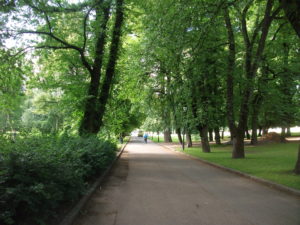 The path lay through the Royal Palace grounds. You can, by the way, take a tour of the palace, although we noticed that it was not included in Oslopass. With only one day, we regrettably decided to pass on the experience, but we certainly enjoyed the spacious grounds and shot some photos. We then followed our directions to the pier, only to find ourselves also passing the National Theatre, a delightful old building that made me wish we could stay to enjoy a concert. Again, time was our enemy. We shot more photos and continued to the pier, passing Oslo City Hall as well on the way because it sits right near the waterfront.
The path lay through the Royal Palace grounds. You can, by the way, take a tour of the palace, although we noticed that it was not included in Oslopass. With only one day, we regrettably decided to pass on the experience, but we certainly enjoyed the spacious grounds and shot some photos. We then followed our directions to the pier, only to find ourselves also passing the National Theatre, a delightful old building that made me wish we could stay to enjoy a concert. Again, time was our enemy. We shot more photos and continued to the pier, passing Oslo City Hall as well on the way because it sits right near the waterfront.
At that point, we unexpectedly discovered something we inexplicably had not thought about, but which was in the Oslopass package. The Nobel Peace Museum, with exhibits about the history of the Nobel Peace Prize and a nice gift shop for those seeking mementoes or books, sits right across from the dock. It was a wonderful serendipitous discovery, and we decided we would be fools not to visit.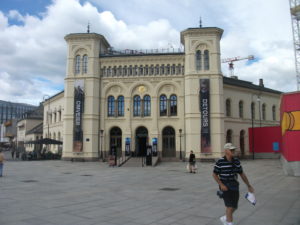
Those less inclined to ponder some of the most serious questions of modern history may not enjoy the museum as we did. The current exhibit dealt with the efforts of Colombian President Juan Manuel Santos (the 2016 winner) to bring peace to his nation by negotiating a pact with the FARC rebels, ending a conflict that had raged for nearly five decades in some form, costing the lives of thousands of Colombian citizens killed by rebels or paramilitary forces, often in connection with deadly drug cartels. Those stories are sobering enough. But there is a room illuminated by soft glow lights with haunting background music and winding rows of brief explanations about the dozens of Nobel Peace Prize winners since the beginning of the 20th century. One soon realizes, even in a cursory review of their stories, how many people have laid their lives on the line to advance world peace. If you have a decent shred of humanity in your bones, walking through this chamber will be a very humbling experience. It was clear to me that, whatever I thought I had contributed to the betterment of humanity, it pales alongside the sacrifices of these noble men and women.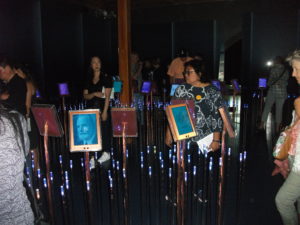
One of the most striking cases was that of Carl von Ossietzky, a German pacifist arrested by the Nazis in 1933 and awarded the prize in 1935. Despite his poor health, the German government refused to allow him to leave the concentration camps to accept the prize. He died in 1938, still in the camps. His award infuriated Hitler, and the government demanded that he decline the honor, which he refused to do. Years later, a similar scenario played out in the Chinese government’s angry response to the Nobel committee honoring dissident Liu Xiaobo, who later died while under house arrest. Speaking truth to power remains a very hazardous occupation.
It was still only late morning when we emerged and found our way to the nearby 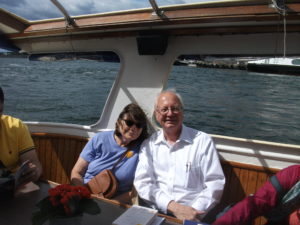 Bygdøy ferry. The ferry provided its own joy as we exchanged cameras with nearby couples for photos. Not sure who among our fellow passengers spoke what languages, I overheard a family conversing in Spanish and asked them if they would shoot our photo. I immediately learned they also spoke English and were from San Diego. They obliged, we obliged, other people obliged, and we all ended up with something better than selfies because we had made some momentary friends. It did not matter that we would probably never meet again; we had broken the ice for our short journey across the bay on a sunny, breezy day.
Bygdøy ferry. The ferry provided its own joy as we exchanged cameras with nearby couples for photos. Not sure who among our fellow passengers spoke what languages, I overheard a family conversing in Spanish and asked them if they would shoot our photo. I immediately learned they also spoke English and were from San Diego. They obliged, we obliged, other people obliged, and we all ended up with something better than selfies because we had made some momentary friends. It did not matter that we would probably never meet again; we had broken the ice for our short journey across the bay on a sunny, breezy day.
 And so, we all went our own ways once we went ashore. Bygdøy has two primary attractions for visitors, the Viking Ship Museum and the Norwegian Folk Museum. My wife opted for the latter, although I might like to have found time for the former as well. In either case, the route involves walking uphill along a charming residential street and then following signs to the museum of your choice. This apparently prosperous residential area features very attractive hillside vistas above the harbor.
And so, we all went our own ways once we went ashore. Bygdøy has two primary attractions for visitors, the Viking Ship Museum and the Norwegian Folk Museum. My wife opted for the latter, although I might like to have found time for the former as well. In either case, the route involves walking uphill along a charming residential street and then following signs to the museum of your choice. This apparently prosperous residential area features very attractive hillside vistas above the harbor.
The Folkemuseum can easily justify several hours of devotion with indoor and outdoor exhibits. The indoor exhibits are in large brick buildings closer to the Visitor’s Center and gift shop near the main entrance. They include some Norwegian art, a rather frank photographic discussion of both Sami culture and the history of social discrimination against the indigenous Sami people, for which the Norwegian king and queen issued a formal apology in recent years, and the difficult role of homosexuals in that environment. There is also a display concerning the role of the Reformation in Norwegian history and culture. In the 16th century, as many people are aware, Norway broke from the Roman Catholic Church to become a predominantly Lutheran nation. Several centuries earlier, Norway and Sweden experienced dramatic changes when Christianity was introduced into a previously pagan Viking culture. Scandinavia was never the same again, and Viking culture, as such, ceased to exist.
Life in those times could be harsh and bleak in Norway because, despite the striking beauty of the landscape, it was also difficult for farming. Much of the land is mountainous, and landholdings were generally small. These and other factors drove much of the immigration to the United States by the 19th century. One gets some sense
of this history from looking at the preserved barns, farmhouses, and other buildings in the numerous outdoor exhibits that line dirt walking paths throughout the museum’s domain. While my wife chose to sit and rest at one point, I climbed a hill on the eastern end of the museum grounds to find a preserved stave church at the top. To my surprise, the interior did not seem very big, and it also seemed largely dark and foreboding. A painted communion scene illustrates the wooden walls behind the altar. Stave churches relied on wood construction without nails, using the skills of medieval master craftsman to fit supporting beams (staves) into perfectly fitted crossbeams to create what today is a precious piece of the world’s architectural heritage. I acquired a book about this phenomenon and have learned that, while medieval Norwegian Christians built about 1,000 of these structures, only 29 remain, largely in the hands of preservation organizations. The Gol church I saw was slated for demolition when it was replaced in its home town by a new structure in 1882, but King Oscar II of Sweden purchased it and donated it to the museum, which then reconstructed it on its current site in 1885. While a mere handful of stave churches continue to function as parish churches today, most experienced salvation as this one did, usually being acquired by one of several preservation organizations functioning in Norway, which typically reopen the buildings as museums as a means of supporting their efforts.
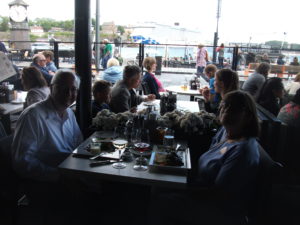 By late afternoon, however, we caught the ferry back to downtown Oslo. We wandered along the waterfront, checking out the menus in the various waterfront restaurants until we found something sufficiently Norwegian to satisfy our curious palates. (Oslo, like any major city, has developed a diverse cuisine and imported other cuisines that provide a range of options for citizens and visitors alike.) We ended up at Louise Restaurant & Bar. My wife decided to be brave and try cheek of beef, which she had never had before, while I opted for salmon; as we often do, we exchanged samples. Frankly, her choice had much of the taste and texture of pot roast and was much less exotic than she feared. Both dishes included other well-prepared ingredients that added to their appeal, such as potatoes, kale, and cauliflower. Although a retired Norwegian airline pilot we met later informed us that other restaurants in town were less expensive, we relished the waterfront ambience on the last evening we would spend in Oslo. I understand his perspective; I don’t often eat at waterfront restaurants in Chicago, but that is in part because they occupy such familiar territory. We were in Oslo just this once, and we meant to enjoy it. When we were done, we hiked back to our hotel and settled in, knowing we would need to rise early the next morning for an adventure I will describe in the next installment.
By late afternoon, however, we caught the ferry back to downtown Oslo. We wandered along the waterfront, checking out the menus in the various waterfront restaurants until we found something sufficiently Norwegian to satisfy our curious palates. (Oslo, like any major city, has developed a diverse cuisine and imported other cuisines that provide a range of options for citizens and visitors alike.) We ended up at Louise Restaurant & Bar. My wife decided to be brave and try cheek of beef, which she had never had before, while I opted for salmon; as we often do, we exchanged samples. Frankly, her choice had much of the taste and texture of pot roast and was much less exotic than she feared. Both dishes included other well-prepared ingredients that added to their appeal, such as potatoes, kale, and cauliflower. Although a retired Norwegian airline pilot we met later informed us that other restaurants in town were less expensive, we relished the waterfront ambience on the last evening we would spend in Oslo. I understand his perspective; I don’t often eat at waterfront restaurants in Chicago, but that is in part because they occupy such familiar territory. We were in Oslo just this once, and we meant to enjoy it. When we were done, we hiked back to our hotel and settled in, knowing we would need to rise early the next morning for an adventure I will describe in the next installment.
Jim Schwab
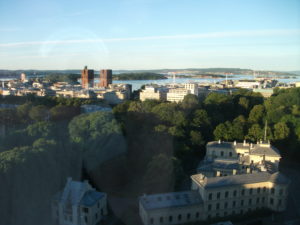
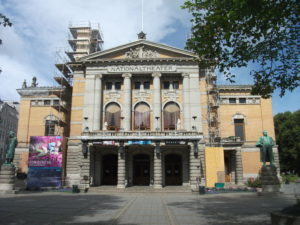
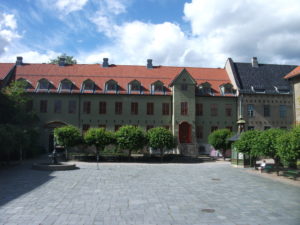
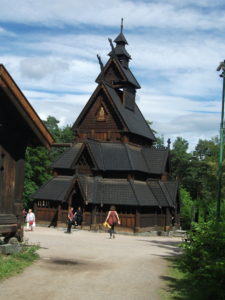
Trackbacks/Pingbacks